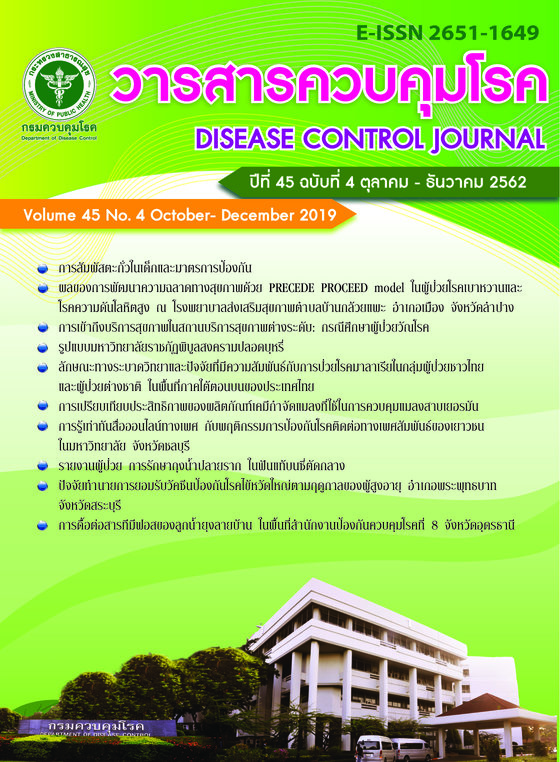Epidemiological characteristics and factors related to malarial disease in Thai and migrant patients in the upper part of southern Thailand
DOI:
https://doi.org/10.14456/dcj.2019.35Keywords:
malaria, Thai patient, migrant patientAbstract
Malaria is a public health problem in Thailand. The purpose of this study was to investigate epidemiological characteristics of malaria transmission and factors related to illness among Thai and migrant patients in Thailand’s upper south. The secondary data of malaria cases derived from malaria online program comprising 5,541 new cases during 2013-2016 were analyzed to determine factors related to malaria incidence using R-program. The study indicated that epidemiological characteristics of malaria in Thai and migrant patients were similar. Most cases were males of working age group and rubber plantation workers. Most migrant patients were reported in Ranong Province (64.4%), whereas most Thai patients were reported in Surat Thani Province (40.2%). Malaria cases typically peaked in May and June. Majority of cases contracted malaria in periodic transmission areas (A2 area). Plasmodium falciparum was the most common parasites (60.1%) among Thai cases, whereas Plasmodium vivax was the most common parasites among non-Thai migrant patients (56.7%). Majority of Thai patients were found in Surat Thani, Phang-Nga, Nakhon Si Thammarat and Krabi Provinces, whereas most migrants patients were found in Phuket, Ranong and Chumphon Provinces. Migrant patients had 3 times higher history of traveling outside their area of residence than Thai patients. The rates of sleeping under mosquito nets and use of mosquito repellents were higher among the Thais than the migrants. Residual spraying of houses and case detection in communities were conducted for Thai patients at higher rates than those of the migrants. Factors significantly related to contracting malaria in Thai patients and migrants were gender, age, occupation, travel history, sleeping under mosquito net, place of malaria transmission, ecological characters, insecticide spraying in malaria transmission foci, focal spraying of patient house, and active case detection of new cases in the community. The study results can be used for planning, surveillance, prevention and control, risk communications to influence behavioral change relating to personal protection from mosquitoes while tapping rubber and at home so as to achieve elimination goal of the malaria program in Thailand.
References
2. World Health Organization. World malaria report 2017 [Internet]. Geneva: World Health Organization; 2017 [cited 2019 Jan 29]. 196 p. Available from: https://www.who.int/docs/default-source/documents/world-malaria-report-2017.pdf?sfvrsn=8b7b573a_0
3. Bureau of Vector-Borne Diseases. Annual Report 2011-2015. Nonthaburi: Bureau of Vector-Borne Diseases; 2015. (in Thai)
4. World Health Organization. World malaria report 2016 [Internet]. Geneva: World Health Organization; 2016 [cited 2019 Jan 29]. 186 p. Available from: https://apps.who.int/iris/bitstream/handle/10665/252038/9789241511711-eng.pdf
5. Bureau of Vector-Borne Diseases. Online malaria database [Internet]. [cited 2018 Mar 20]. Available from: https://malaria.ddc.moph.go.th/malariaR10/ (in Thai)
6. World Health Organization. Global technical strategy for malaria 2016-2030 [Internet]. Geneva: World Health Organization; 2016 [cited 2018 Mar 24]. 32 p. Available from:
https://www.who.int/malaria/publications/atoz/9789241564991/en/
7. Bureau of Vector-Borne Diseases. National malaria elimination strategy, Thailand 2017-2026. Nonthaburi: Bureau of Vector-Borne Diseases; 2015. (in Thai)
8. Bureau of Vector-Borne Diseases. Guidelines on malaria control for public health workers, 2009. 2nd ed. Nonthaburi: Bureau of Vector-Borne Diseases; 2009. (in Thai)
9. Health Systems Research Institute. Foreign migrant workers and notifiable diseases. [Internet]. [cited 2018 Mar 20]. Available from: www.hsri.or.th/people/media/care/detail/5529 (in Thai)
10. Department of Employment. Situations of migrant workers in Thailand [Internet]. [cited 2018 Mar 20]. Available from: https://www.doe.go.th/prd/alien/statistic/param/site/152/cat/82/sub/0/pull/category/view/list-label (in Thai)
11. Chujun S, Konglai K. Appropriate approach to the malaria prevention and control among migrant workers in the high incidence area of Ranong Province. Journal of vector borne disease 2012;2:45-55. (in Thai)
12. Saisin S. Protective behaviors for the people seeking malaria diagnosis at malaria clinic, Vector Borne Disease Control Unit 6, Ta Phraya District, Sa Kaeo Province [dissertation]. Bangkok: Mahidol University; 1999. 80 p. (in Thai)
13. Muenrat S. The pattern of health seeking and behavior prevention on malaria patients of the foreign labor in border area, Upper South, Thailand [Internet]. [cited 2018 Mar 20]. Available from: https://irem2.ddc.moph.go.th/research/3924 (in Thai)
14. Chuebangkaew P. Epidemiology and personal protection against malaria in hill tribe people, Wat Chan Sub-district, Mae Chaem District, Chiang Mai Province [dissertation]. Bangkok: Mahidol University; 1998. 157 p. (in Thai)
15. Sudathip P. Risk factors associated with malaria P. falciparum re-infection among malaria patients seeking treatment at malaria clinic, Vector Borne Disease Control Center 53, Kanchanaburi Province [dissertation]. Bangkok: Mahidol University; 1998. 91 p. (in Thai)
16. Sriwichai P, Karl S, Samung Y, Kiattibutr K, Sirichaisinthop J, Mueller L, et al. Imported Plasmodium falciparum and locally transmitted Plasmodium vivax: cross-border malaria transmission scenario in northwestern Thailand. Malar J 2017;16:258-67.
17. Hanandita W, Tammpubo G. Geography and social distribution of malaria in Indonesian Papua: a cross-sectional study. Int J Health Geogr 2016;15:13-28.
18. National Institute of Health of Thailand. Ecological biology and mosquito control in Thailand. 4th ed. Nonthaburi: National Institute of Health of Thailand; 2001. (in Thai)
19. Bureau of Vector-Borne Diseases. Entomology database [Internet]. [cited 2018 Mar 20]. Available from: www.thaivbd.org/entomological (in Thai)
20. Lonsunthorn P. Epidemiology. 3rd ed. Bangkok: Chulalongkorn University; 1997. (in Thai)
21. Wikipedia. Surat Thani [Internet]. [cited 2018 Mar 20]. Available from: https://en.wikipedia.org/wiki/Surat_Thani
22. Department of Employment. Statistics journal of the current number of foreign migrant patients who are allowed to work throughout the Kingdom in 2015 [Internet]. [cited 2018 Mar 20]. Available from:
https://www.doe.go.th/prd/assets/upload/files/alien_th/9543df52b3c6627a674841501f323738.pdf (in Thai)
23. Suthirawut T. Public health operation in migrant workers [Internet]. [cited 2018 Mar 20]. Available from: https://www.boe.moph.go.th/files/meeting/slide_IHR_2DEC_pdf/3.pdf in Thai)
24. Muenrat Y. Epidemiology and behavior of malaria prevention of foreign workers in high risk areas of Ranong Province [Internet]. [cited 2018 Mar 20]. Available from: https://kb.hsri.or.th/dspace/handle/11228/1203?locale-attribute=th (in Thai)
25. Fungladda W, Sornmani S, Klongkamnuankarn K, Hungsapruek T. Sociodemographic and behavioral factor associated with hospital malaria patient in Kanchanaburi, Thanland. J Trop Med Hyg 1987;90:233-7.
Downloads
Published
How to Cite
Issue
Section
License
Articles published in the Disease Control Journal are considered as academic work, research or analysis of the personal opinion of the authors, not the opinion of the Thailand Department of Disease Control or editorial team. The authors must be responsible for their articles.



.png)



